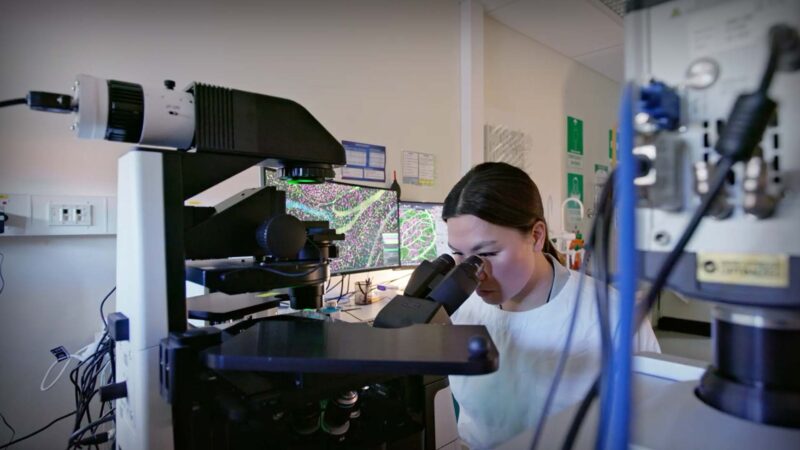CORNEAL AND OCULAR SURFACE IMMUNOLOGY AND REGENERATION
Associate Professor Holly Chinnery,
Inaugural Ian Constable Research Fellow,
Lions Eye Institute,
UWA Optometry at The University of Western Australia
RESEARCHER PROFILE
Filmed in Perth, Western Australia | November 2024
Associate Professor Holly Chinnery is a teaching and research academic in the field of corneal and ocular immunology who has spent her career teaching anatomy and immunology to Optometry students at the University of Melbourne and now at UWA, while also leading a Corneal and Ocular Immunology Research team.
Career highlights include:
– Leading a team of students and early career staff over the past 15 years working on corneal and retinal immunology, a co-leading the FrontTear Research Centre with Professor Laura Downie at the University of Melbourne https://www.fronttear.au/
– Receiving NH&MRC Ideas and ARC Discovery Grant funding
– Speaking invitations at Oxford University, University of Birmingham and the Association for Research in Vision and Ophthalmology; and recent publications in PNAS and Nature Reviews Immunology.
Assoc Professor Chinnery’s career in ocular immunology began with a focus on animal models; however, it has recently transitioned into clinical imaging studies involving human research participants. The ability to visualise the immune system and sensory nerves in the human cornea represents a significant advantage in corneal immunology and neuroimmunology research.
This advancement is made possible through a methodology called Functional In Vivo Confocal Microscopy (Fun-IVCM), which enables the observation of immune cell dynamics in the living human eye. Utilising this technology led to a breakthrough in the field of ocular immunology, culminating in a report published in PNAS, a highly prestigious journal, regarding the presence of T cells in the healthy human cornea https://www.pnas.org/doi/full/10.1073/pnas.2217795120.
This finding challenges existing dogmas and is poised to reshape the field of corneal immunology, prompting a reconsideration of previously held beliefs about how the cornea manages inflammation and immune protection, with direct implications for healthy vision.
For the first time, a variety of immune cells can be visualised in the living human cornea, generating a wealth of new questions about immunology, cell biology, and the effects that diseases outside the eye have on immune cells at the eye’s surface.
In her recent appointment at the Lions Eye Institute, Assoc Professor Chinnery aims to establish and support a team of researchers focused on corneal and ocular surface regeneration, which is one of the key research priorities of the Institute.
You Might also like
-
Behavioural science in cancer screening, control and communication
Dr Dodd has an established international reputation as a behavioural scientist in cancer control and communication. Since completing her PhD in 2016, Dr Dodd has been awarded a three-year University of Sydney Postdoctoral Research Fellowship (2018-2021) and a three-year Research Fellowship at The Daffodil Centre (current). Dr Dodd is the co-chair of the ‘Strengthening and optimising approaches to cancer prevention, screening, and early detection’ hub at The Daffodil Centre (with more than 130 staff and students).
-
Nutraceutical and pharmacological intervention in neurological disorders
Dr Virginie Lam is a neuroscientist and cerebrovascular biologist with over 15 years of research experience, including more than seven years post-PhD. She co-leads the Neurovascular and Metabolic Diseases Laboratory at the Curtin Medical Research Institute and holds an affiliate appointment at the Perron Institute for Neurological and Translational Science. Her research focuses on the interface between neurovascular health, cognitive function, and therapeutic translation in neurodegenerative disorders.
-
Ocular disease and early onset myopia
Dr Mountford has successfully established Western Australia’s first and only ocular genetic screening platform using zebrafish and utilises this model to help elucidate some of the complex gene-environment interactions responsible for the development of myopia.



